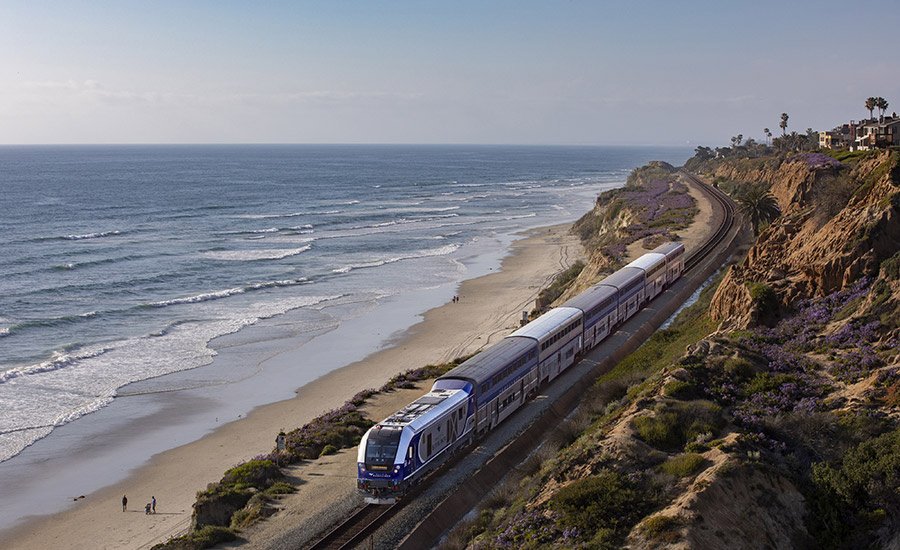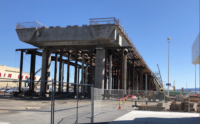Despite recent windfalls from state and federal sources, California transit agencies face major funding questions as a proposed 2023 budget from Gov. Gavin Newsom (D) includes major cuts in rail projects to help manage a $22.5-billion deficit attributed to inflation and market conditions. The governor's proposed $297-billion state budget includes a $2-billion cut in rail projects as well as cutting $2.5 billion for zero-emission vehicle credits and infrastructure programs.
“The Governor has built in a trigger so that the transportation cuts would return in the 2024 budget if sufficient funds are available to cover certain commitments, but that is not a guarantee and does not allow agencies to plan for the future with much certainty," explained Brandon Davis, a partner with Nossaman, a law firm that specializes in public infrastructure.
That uncertainty creates concerns for agencies grappling with long-term cost projections needed to handle major projects and meet future environmental impact targets.
Although a $12-million project to stabilize a 700-ft-long section of track on the Orange County Transportation Authority-owned Orange County Line and Inland Empire-Orange County Line in San Clemente won’t be affected by the proposed budget cuts, OCTA said it was “joining with the California Transit Association and other transit agencies across the state in urging the Governor to reconsider these cuts to transit capital funding,” says OCTA spokesperson Eric Carpenter.
OCTA had been expecting approximately $320 million over two years based on what the state had previously promised in formula funding, he notes. “With the proposed cuts, it would now mean half of that—or approximately $160 million—over three years instead of two.” OCTA plans to convert to a full zero-emission fleet by 2040, as required by the state. The current funding gap to accomplish this is approximately $400 million.
“Because OCTA has been very conservative in our finances and budgeting, we don’t anticipate having to make cuts to existing services,” says Carpenter. “But it does cut into funds that could be used for improving Orange County’s transportation network and the ability to expand services. It also inhibits our ability to work toward state mandates on climate goals, such as the increased cost of transitioning to zero-emission technologies.”
Transit agencies across the nation are struggling to recover lost ridership due to a falloff in use during the COVID-19 pandemic. “We hope the State will fund public transportation at a level commensurate with its importance in advancing mobility, equity and reducing greenhouse gas emissions,” said Jim Allison, a spokesperson for Bay Area Rapid Transit. “BART is in dire straits financially. BART is now running service using one-time federal emergency funds that will run out in 2025. California can’t afford to lose transit.”
Influx of Existing Funds
Even as Newsom’s proposed budget slashes $6 billion for climate initiatives, including half for the state’s clean transportation initiatives, the state is pushing out funds already allotted. For example, on Jan. 31 Newsom announced $2.5 billion in funding for 16 transit projects across the state.
The funding is part of the state's 2023 Transit and Intercity Rail Capital Program (TIRCP), which will provide a total of $2.5 billion to projects across California that reduce greenhouse gas (GHG) emissions by improving rail and transit services. The TIRCP program is funded through Senate Bill (SB) 1 and is an extension of the state's Cap and Trade program.
One key beneficiary of the program was the The Los Angeles – San Diego – San Luis Obispo (LOSSAN) Rail Corridor Agency, which manages the Amtrak Pacific Surfliner service. The agency received $31 million to fund a package of projects that will expand and improve passenger rail service in southern California, the California State Transportation Agency (CalSTA).
“The TIRCP awards that the Governor announced on January 31st show that the administration is committed to making sure that key projects in both Northern and Southern California move forward,” Davis says. “Nevertheless, the previously announced budget cuts mean that agencies will need to push some projects out at least a year or two. That includes delaying projects aimed at addressing climate change and the mobility of lower-income residents.”
Another key project receiving funds is the Santa Clara Valley Transportation Authority (VTA) for its BART extension into Downtown San Jose and Santa Clara. The $375 million in funds this year makes a total $1.125 billion in TIRCP money the state has contributed to the project. That funding is critical to allow the agency to qualify for roughly $4.6 billion in a federal contribution, approximately 50% of the estimated project cost, VTA officials say.
In late January, the Otay Mesa Port of entry project was awarded $150 million from the U.S. Dept. of Transportation’s “Mega” program, part of the Infrastructure Investment and Jobs Act. The project involves the construction of a new road, State Route 11, as well as a Port of Entry facility at Otay Mesa near San Diego.
Other agencies have also been aggressive in seeking out federal sources of funding to bolster state support. Senators Dianne Feinstein (D-Calif.) and Alex Padilla (D-Calif.) on Jan. 31 announced that California was awarded nearly $133 million through the Department of Transportation’s Safe Streets and Roads for All (SS4A) Grant Program, created under the IIJA.
However, the proposed future cuts loom large. “Transit agencies across the state are facing difficult fiscal conditions as we all continue trying to regain pre-pandemic ridership and federal transit emergency aid is exhausted,” says Carpenter.
2023 Transit and Intercity Rail Program
| Project | Agency | Award |
| Transbay Corridor Core Capacity Program (TCCCP) | Bay Area Rapid Transit (BART) | $250M |
| Sacramento to Roseville Third Track Project | Capitol Corridor Joint Powers Authority (CCJPA) | $30M |
| Inglewood Transit Connector (ITC) | City of Inglewood | $407.4M |
| East San Fernando Valley (ESFV) Transit Corridor | Los Angeles County Metropolitan Transportation Authority (LA Metro) | $600M |
| Corridor Hardening | LOSSAN Rail Corridor Agency (LOSSAN) | $6.6M |
| Central Coast Layover Facility | LOSSAN Rail Corridor Agency (LOSSAN) | $14M |
| OC Streetcar | Orange County Transportation Authority (OCTA) | $149.8M |
| Peninsula Corridor Electrification Project | Peninsula Corridor Joint Powers Board (PCJPB) | $367M |
| Diesel Multiple Unit (DMU) Vehicles to Zero-Emission Vehicle (ZEMU) Conversion | San Bernardino County Transportation Authority (SBCTA) | $15.8M |
| West Valley Connector Bus Rapid Transit Phase 1 & Zero-Emission Bus Initiative | San Bernardino County Transportation Authority (SBCTA) | $18.8M |
| University Bikeway Project | San Diego Association of Governments (SANDAG) | $4.2M |
| Valley Rail | San Joaquin Joint Powers Authority (SJJPA) and San Joaquin Regional Rail Commission (SJRRC) | $141.9M |
| Goleta Train Depot Improvements | Santa Barbara County Association of Governments (SBCAG) | $5.6M |
| BART Silicon Valley Phase II Extension Project | Santa Clara Valley Transportation Authority (VTA) | $375M |
| Larkspur to Windsor Corridor Project | Sonoma-Marin Area Rail Transit (SMART) | $34.3M |
|
El Monte Siding & Station Improvements,
Fullerton Junction Reconfiguration & Fullerton to Esperanza 3rd Track, Simi Valley Double Track |
Southern California Regional Rail Authority (Metrolink) | $106.9M |





Post a comment to this article
Report Abusive Comment